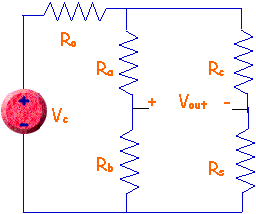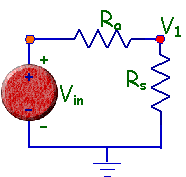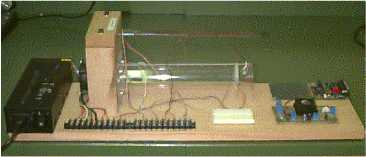| Strain Gages |
A strain gage
is a resistor in which the resistance changes with strain. A strain gage
is a thin piece of conducting material that may look like the drawing below.
(Although, there are also semiconductor strain gages - not covered here.)
It is literally glued on to the device where you want to measure strain.
If you want more information on strain gages, it is a good idea to check with
manufacturers. Here are some good links.
-
Omega Engineering - A nice writeup about strain gage basics.
-
Vishay
- Links to catalogs
-
NMB Products - a page on strain gage selection
-
Entran
- A page that gives good definitions of strain gage terms
-
efunda
- Go to this page if you want a more theoretical treatment of strain gages.
-
PennState
- Another learning resource.
Now, assume that you have a strain gage glued on a device and the device is
under stress. When the device-under-test is put under stress it may
elongate or shrink, and the strain gage is sensitive to that small change in
geometry.

The small elongation in the
strain gage produces a small change in the resistance of the strain gage.
Small as it is, it is what we need to use to get a voltage indicative of the
strain in the bar. To convert that small change in resistance into a
usable signal is not impossible, but it takes a little doing. Often, the
strain gage is used is a
bridge circuit like this one.

What are you trying to do in this lesson?
Sensors In Voltage Divider Circuits
The kind of sensor that we will examine is a resistive sensor, and to make
things specific we will look at using a strain gage to make mechanical
measurements of strain. Here's that sensor (Rs)
in a voltage divider with another resistor, Ra.

Let's examine what happens
in this circuit. Some of the things that happen in this circuit include
the following.
-
When the sensor resistance
changes, the output voltage changes.
-
Although the voltage changes,
if the resistance change is small, then the voltage change will also be small.
-
When the supply voltage
changes, the output voltage will also change.
-
Let's assume that we have a
typical strain gage. Normally a strain gage has a nominal resistance of
either 120Wor 350W.
Here is how a strain gage looks.
-
We need to remember that strain
is the fractional change in length in a material when the material is stressed.
It is normally measured in inches/inch (or you could make that furlongs/furlong
if you like.)
-
Normally, in most metals, for
instance, the strain will not exceed .005 inch/inch.
-
The material will elongate no
more than .5 inches in a 100 inch long piece of material.
-
If the maximum strain is .005
(.5%) then the maximum fractional change in resistance will be 1% - and that is
far larger than you would expect to see since it is an extreme case.

-
We went into the laboratory
where we have some strain gages attached to a ten inch bar of .05" thickness.
-
That's shown at the top of the
picture, where the bar extends from the wooden block.
-
We had strain gages on both the
top of the bar and underneath the bar so that one would always elongate and the
other would compress.
-
The bar is clamped at one end
and the other end is free. Putting 75 cents (three US quarters) on the
free end of the bar produced no measurable change in resistance with a 5-1/2
digit ohmmeter.
-
However an overloaded wallet
(about 1/2 pound) changed resistance from 350.550Wto 350.520W.
The change in resistance can be very small.
Now, if we have some sense of the resistance change, then we can think about how
we will sense that change. Because the change is very very small we
will have to worry about how we are going to use that very small change in
resistance We have at least a couple of options for how we can make that
measurement.
-
We can measure resistance
directly. But as we have seen, the resistance change is very small and
ohmmeters will have trouble showing us much.
-
We can put the strain gage in a
circuit like a voltage divider, letting the change in resistance cause a voltage
change and measure that change. We will need to check to see if that makes
our situation any better.
-
Our problem is complicated by
the fact that most devices that are used for electrical measurements will
measure DC voltage. The ohmmeter is an exception. But if we want to
get our measurements into a computer and we don't want to type them in, we'll
probably need a voltage.
-
So, we conclude that the
voltage divider (below) is a good idea in some ways.

Let's compute the output voltage for the voltage divider.
V1
= Vin Rs/( Ra + Rs)
Now, let's compute some typical values.
Now, we can check what happens when the resistance changes by a typical small
amount.
-
We will assume that the
resistance changes from 350 to 350.03W.
The typical small change we discussed earlier.
-
The question we need to answer
is "How much does the output voltage change when the resistance changes from 350
to 350.03W?"
We can compute the output for
both cases.
-
When the sensor is unstrained
and has a resistance of 350W,
the output is:
-
V1 = Vin/2.
Remember we are assuming that Ra
= 350W.
-
When the strain gage sensor
changes to 350.03W,
the output changes to:
That's a pretty small change in the output voltage.
-
When the sensor is unstrained
and has a resistance of 350W,
the output is:
-
V1 = Vin/2.
Remember we are assuming that Ra = 350W.
-
When the strain gage sensor
changes to 350.03W,
the output changes to:
|

